Glacial Lakes of Mongolia
Abstract
1. Introduction
2. History of Research on Mongolian Lakes
2.1. Earlier Studies and Geography
2.2. Hydrobiology
2.3. Paleolimnology
3. Classification of Mongolian Lakes
- Lakes formed by geologic-tectonic processes.
- 1.1.
- Lakes in subsidence depressions in regions of slow tectonic movement: Uvs Nuur in Uvs Aimag; Khirgas Nuur in Uvs Aimag.
- 1.2.
- Lakes in fault lines: Khuvsgul, Orog Nuur, and Sangiin Dalay Nuur in Khuvsgul Aimag; Bayan Nuur in Uvs Aimag; Bust Nuur in Zavkhan Aimag.
- 1.3.
- Endorheic lakes with past or present glacier meltwater inflow: Khar Us Nuur in Khovd Aimag; Shaazgai Nuur in Uvs Aimag.
- Lakes formed by geomorphological processes.
- 2.1.
- Glacial processes, exaration, and accumulation: Khar Nuur in Tsengel Sum.
- 2.2.
- Permafrost processes, freeze–thaw dynamics, thermokarst lakes: Chuluut in Arkhangai Aimag.
- 2.3.
- Fluvial processes, e.g., oxbow lake: Ugii Nuur in Arkhangai Aimag.
- 2.4.
- Aeolian processes: Bayan Nuur in Zavkhan Aimag.
- 2.5.
- Volcanic processes: depressions, damming: Terkhin Tsagaan Nuur in Arkhangai Aimag.
- Lakes formed by multiple processes: Bayan Nuur in Uvs Aimag.The glacial lakes can be subdivided as follows:
- 3.1.
- Tarn lakes: lakes in the Khangai, Altai, and Sayan mountains.
- 3.2.
- Tongue-basin lakes: Khukh Nuur in the Khar Zurkhen Mountains.
- 3.3.
- Moraine-dammed lakes: Burideiin Nuur in Munkh Khairkhan Sum; Ikh Hag Nuur; Khar Nuur in Tsengel Sum.
- 3.4.
- Kettle-hole lakes: Olon Nuur at Kharkhiraa Mountain.
- 3.5.
- Ice-contact lakes: at Munkh Khairkhan and in Rhashant Gol.
- 3.6.
- Combined proglacial lakes: lakes east of Tsengel Khairkhan; Rhashant Nuur at Kharkhiraa Mountain.
- 3.7.
- Endorheic lakes of meltwater: Khar Us Nuur, Shaazgai Nuur, Tsetseg Nuur in Khovd Aimag; Uvs Nuur in Uvs Aimag.
4. Moraine-Dammed Lakes
4.1. Khar Nuur, Tsengel Sum
4.2. Ikh Hag Nuur, Tsengel Sum
4.3. Burideiin Nuur, Munkh Khairkhan National Park
5. Tongue-Basin (Zungenbecken) Lakes
5.1. Tsengel Khairkhan Lakes, Tsengel Sum
5.2. Rhashant Gol Lakes, Kharkhiraa Mountains
6. Ice-Contact Lakes
6.1. Munkh Khairkhan Lake 4, Munkh Khairkhan Mountains
6.2. Rhashant Gol Lake 3, Kharkhiraa Mountains
7. Endorheic Lakes
8. Discussion
9. Conclusions
Author Contributions
Funding
Data Availability Statement
Conflicts of Interest
References
- Wang, X.; Siegert, F.; Zhou, A.; Franke, J. Glacier and glacial lake changes and their relationship in the context of climate change, Central Tibetan Plateau 1972–2010. Glob. Planet. Change 2013, 111, 246–257. [Google Scholar] [CrossRef]
- Luo, W.; Zhang, G.; Chen, W.; Xu, F. Response of glacial lakes to glacier and climate changes in the western Nyainqentanglha range. Sci. Total Environ. 2020, 735, 139607. [Google Scholar] [CrossRef] [PubMed]
- Demberel, O.; Munkhbat, B.; Dorjsuren, B.; Callaghan, T.V.; Tsogoo, B.; Zemtsov, V.A.; Shaarav, O.; Gongor, E.; Jargalsaikhan, Z.; Ganhuyag, N.; et al. Relationship between dynamics of modern glaciers of the Mt. Munkhkhairkhan (Mongolian Altai) and climate. Water 2023, 15, 1921. [Google Scholar] [CrossRef]
- Khadka, N.; Chen, X.; Sharma, S.; Shrestha, B. Climate change and its impacts on glaciers and glacial lakes in Nepal Himalayas. Reg. Environ. Change 2023, 23, 143. [Google Scholar] [CrossRef]
- Larsen, C.F.; Burgess, E.; Arendt, A.; O’Neel, S.; Johnson, A.J.; Kienholz, C. Surface melt dominates Alaska glacier mass balance. Geophys. Res. Lett. 2015, 42, 5902–5908. [Google Scholar] [CrossRef]
- Shugar, D.H.; Burr, A.; Haritashya, U.K.; Kargel, J.S.; Watson, C.S.; Kennedy, M.C.; Bevington, A.R.; Betts, R.A.; Harrison, S.; Strattman, K. Rapid worldwide growth of glacial lakes since 1990. Nat. Clim. Change 2020, 10, 939–945. [Google Scholar] [CrossRef]
- Shrestha, B.; Mool, P.K.; Bajracharya, S.R. Impact of Climate Change on Himalayan Glaciers and Glacial Lakes: Case Studies on GLOF and Associated Hazards in Nepal and Bhutan; ICIMOD: Kathmandu, Nepal, 2007. [Google Scholar]
- Harrison, S.; Kargel, J.S.; Huggel, C.; Reynolds, J.; Shugar, D.H.; Betts, R.A.; Emmer, A.; Glasser, N.; Haritashya, U.K.; Klimeš, J.; et al. Climate change and the global pattern of moraine-dammed glacial lake outburst floods. Cryosphere 2018, 12, 1195–1209. [Google Scholar] [CrossRef]
- Nie, Y.; Liu, Q.; Wang, J.; Zhang, Y.; Sheng, Y.; Liu, S. An inventory of historical glacial lake outburst floods in the Himalayas based on remote sensing observations and geomorphological analysis. Geomorphology 2018, 308, 91–106. [Google Scholar] [CrossRef]
- Ahmed, R.; Wani, G.F.; Ahmad, S.T.; Sahana, M.; Singh, H.; Ahmed, P. A review of glacial lake expansion and associated glacial lake outburst floods in the Himalayan region. Earth Syst. Environ. 2021, 5, 695–708. [Google Scholar] [CrossRef]
- Liu, Z.; Yang, Z.; He, N.; Wei, L.; Zhu, Y.; Jiao, W.; Wang, Z.; Zhang, T.; Zhang, J.; Zou, X. Three decades of glacial lake research: A bibliometric and visual analysis of glacial lake identification. Front. Ecol. Evol. 2023, 11, 1296111. [Google Scholar] [CrossRef]
- National Office of Statistics. Yearbook 2016; National Office of Statistics: Ulaanbaatar, Mongolia, 2016. (In Mongolian) [Google Scholar]
- Baldandorj, T. Water Resource and Its Appropriate Usage; Munkhiin Useg: Ulaanbaatar, Mongolia, 2017; Volume II. (In Mongolian) [Google Scholar]
- Walther, M. Paleoenvironmental changes in the Uvs Nuur basin (Northwest Mongolia). Explor. Into Biol. Resour. Mong. 2010, 11, 267–280. [Google Scholar]
- Walther, M.; Enkhjargal, V.; Gegeensuvd, T.; Odbaatar, E. Environmental changes of Orog Nuur (Bayan Khongor Aimag, south Mongolia): Lake deposits, paleo-shorelines and vegetation history. Explor. Into Biol. Resour. Mong. 2016, 13, 37–57. [Google Scholar]
- Walther, M.; Dashtseren, A.; Kamp, U.; Temujin, K.; Meixner, F.; Pan, C.G.; Gansukh, Y. Glaciers, permafrost and lake levels at Tsengel Khairkhan Massif, Mongolian Altai, during the Late Pleistocene and Holocene. Geosciences 2017, 7, 73. [Google Scholar] [CrossRef]
- Walther, M.; Horn, W.; Dashtseren, A. Uvs Nuur: A sentinel for climate change in eastern Central Asia. In Large Asian Lakes in a Changing World; Mischke, S., Ed.; Springer: New York, NY, USA, 2020; pp. 235–257. [Google Scholar]
- Naumann, S.; Walther, M. Mid-Holocene lake level fluctuations of Bajan Nuur (NW Mongolia). Marbg. Geogr. Schriften 2000, 135, 15–27. [Google Scholar]
- Grunert, J.; Lehmkuhl, F.; Walther, M. Paleoclimatic evolution of the Uvs Nuur basin and adjacent areas (Western Mongolia). Quat. Int. 2000, 65/66, 171–192. [Google Scholar] [CrossRef]
- Navchaa, T. Hydrography of Mongolia. In The Physical Geography of Mongolia; Batchuluun, Y., Ed.; Springer Nature: Bern, Switzerland, 2021; pp. 77–100. [Google Scholar]
- Chen, F.; Zhang, M.; Guo, H.; Allen, S.; Kargel, J.S.; Haritashya, U.K.; Watson, C.S. Annual 30 m dataset for glacial lakes in High Mountain Asia from 2008 to 2017. Earth Syst. Sci. Data 2021, 13, 741–766. [Google Scholar] [CrossRef]
- Kamp, U.; Krumwiede, B.S.; McManigal, K.G.; Pan, C.G.; Walther, M.; Dashtseren, A. The glaciers of Mongolia. Inst. Arct. Alp. Res. (INSTAAR) Occas. Pap. 2013, 61, 48p. [Google Scholar]
- Kamp, U.; Pan, C.G. Inventory of glaciers in Mongolia, derived from Landsat imagery from 1989 to 2011. Geogr. Ann. Ser. A Phys. Geogr. 2015, 97, 653–669. [Google Scholar] [CrossRef]
- Pan, C.G.; Pope, A.; Kamp, U.; Dashtseren, A.; Walther, M.; Syromyatina, M.V. Glacier recession in the Altai Mountains of Mongolia in 1990-2016. Geogr. Ann. Ser. A Phys. Geogr. 2017, 100, 185–203. [Google Scholar] [CrossRef]
- Davaa, G. Climate Change Impacts on Water Resources in Mongolia; Institute of Water and Meteorology: Ulaanbaatar, Mongolia, 2010. [Google Scholar]
- Pan, C.G.; Kamp, U.; Munkhjargal, M.; Halvorson, S.J.; Dashtseren, A.; Walther, M. Understanding the contribution and importance of glaciers to regional hydrology in Mongolia’s Altai Mountains. Mt. Res. Dev. 2019, 39, 12–20. [Google Scholar]
- Tsedevdorj, S.-O. Glaciers of Mongolia. In The Physical Geography of Mongolia; Batchuluun, Y., Ed.; Springer Nature: Bern, Switzerland, 2021; pp. 101–117. [Google Scholar]
- Dashtseren, A. Permafrost of Mongolia. In The Physical Geography of Mongolia; Batchuluun, Y., Ed.; Springer Nature: Bern, Switzerland, 2021; pp. 119–133. [Google Scholar]
- Kamp, U.; Walther, M.; Dashtseren, A. Mongolia’s cryosphere. Geomorphology 2022, 410, 108202. [Google Scholar] [CrossRef]
- Walther, M.; Kamp, U. Mountain permafrost: A reflection on the periglacial environment in Mongolia. Geosciences 2023, 13, 274. [Google Scholar] [CrossRef]
- Orkhonselenge, A.; Uuganzaya, M.; Davaagatan, T. Lakes of Mongolia: Geomorphology, Geochemistry and Paleoclimatology; Springer: Cham, Switzerland, 2022. [Google Scholar]
- Enkhbold, A.; Khukhuudei, U.; Doljin, D. A review of modern trends and historical stages of development of lake research in Mongolia. Proc. Mong. Acad. Sci. 2022, 62, 25–37. [Google Scholar] [CrossRef]
- Klinge, M.; Sauer, D. Spatial pattern of Late Glacial and Holocene climatic and environmental development in Western Mongolia—A critical review and synthesis. Quaternay Sci. 2019, 210, 26–50. [Google Scholar] [CrossRef]
- Khenzykhenova, F.; Dorofeyuk, N.; Shchetnikov, A.; Danukalova, G.; Bazarova, V. Palaeoenvironmental and climatic changes during the late Glacial and Holocene in the Mongolia and Baikal region: A review. Quat. Int. 2021, 605/606, 300–328. [Google Scholar] [CrossRef]
- Kondratiev, S. Telmen-Nur and West of Hangai plateau. Econ. Mong. 1929, 11–16. (In Russian) [Google Scholar]
- Smirnov, V. Report on the works of the hydro-chemical group of the Mongolian expedition in 1926. Proc. Mong. Comm. 1932, 1, 1–23. (In Mongolian) [Google Scholar]
- Murzaev, E.M. The Mongolian People’s Republic: A Physical-geographical Description; State Publication of Geographical Literature: Moscow, Russia, 1948. (In Russian) [Google Scholar]
- Kuznetsov, N.T. To the question about water exchange between the lakes in the Depression of the Great Lakes in Mongolia. News Acad. Sci. USSR Geogr. Geophys. Ser. 1951, 5, 272. (In Russian) [Google Scholar]
- Tsegmid, S. 1955. From the past of the Valley of Lakes in the Mongolian Gobi. Natura 1955, 5, 46–49. [Google Scholar]
- Dashdorzh, A. 1973. Materials on fauna of Lake Huvsgul. Stud. Inst. Biol. Mong. Acad. Sci. 1973, 8, 108–112. (In Mongolian) [Google Scholar]
- Tserensodnom, J. Lakes of Mongolia; State Publishing: Ulaanbaatar, Mongolia, 1971. (In Mongolian) [Google Scholar]
- Tserensodnom, J. A Catalogue of Lakes in Mongolia; Shuvuum Saaral Publishing: Ulaanbaatar, Mongolia, 2000. [Google Scholar]
- Martinson, G.G. Mezozoic Lake Depressions of Mongolia; Nauka: Leningrad, Russia, 1982. (In Russian) [Google Scholar]
- Sevastyanov, D.V.; Dorofeyk, N.I. Lakes of the Mongolian People’s Republic and Their Mineral Resources; Nauka: Moscow, Russia, 1991. (In Russian) [Google Scholar]
- Dulmaa, A. Hydrobiology of Darkhad Lake Basin; Mongolian Academy of Sciences: Ulaanbaatar, Mongolia, 1964. (In Mongolian) [Google Scholar]
- Kozhov, M.M. Lake Huvsgul and Opportunities for Its Fish Supply Utilization. Irkutsk, Russia. 1965. (In Russian) [Google Scholar]
- Dulmaa, A.; Nansalmaa, B.; Bullion, V. Natural Conditions and Resources of Lake Huvsgul in the Mongolian People’s Republic; Nauka: Moscow, Russia, 1976. (In Russian) [Google Scholar]
- Sokolov, V.E. Flora and Fauna of Mongolia; Nauka: Moscow, Russia, 1978. (In Russian) [Google Scholar]
- Sokolov, V.E. Fishes of the Mongolian People’s Republic; Nauka: Moscow, Russia, 1983. (In Russian) [Google Scholar]
- Sokolov, V.E. Ecology and Economical Potential of the Fishes of Mongolian People’s Republic; Nauka: Moscow, Russia, 1985. (In Russian) [Google Scholar]
- Avirmed, A. Analysis of the salt composition of Lake Devter. Trans. Inst. Chem. Acad. Sci. 1959, 3/4, 42–52. (In Mongolian) [Google Scholar]
- Sokolov, V.E. Structure and Dynamics of Basic Ecosystems of the Mongolian People’s Republic; Nauka: Moscow, Russia, 1976. (In Russian) [Google Scholar]
- Sokolov, V.E.; Shagdarsuren, O. Natural Conditions, Vegetative Cover and Fauna of Mongolia; Puschino Scientific Centre for Biological Research of the Russian Academy of Sciences: Moscow, Russia, 1988. (In Russian) [Google Scholar]
- Sevastyanov, D.; Shuvalov, V.; Neustrueva, Y. Limnology and Paleolimnology of Mongolia; Nauka: St. Petersburg, Russia, 1994. (In Russian) [Google Scholar]
- Tarasov, P.E.; Pushenk, M.Y.; Harrison, S.P.; Saarse, L.; Andreev, A.A.; Aleshinskaya, Z.V.; Davydova, N.N.; Dorofeyuk, N.I.; Efremov, Y.V.; Elina, G.A.; et al. Lake Status Records from the Former Soviet Union and Mongolia. Documentation of the Second Version of the Data Base; World Data Center-A for Paleoclimatology, NOAA-NGDC Paleoclimatology Program: Boulder, CO, USA, 1996; Volume 5. [Google Scholar]
- Tarasov, P.E.; Webb III, T.; Andreev, A.A.; Afanaseva, N.B.; Berezina, N.A.; Bezusko, L.G.; Blyakharchuk, T.A.; Bolikhovskaya, N.S.; Cheddadi, R.; Chernavskaya, M.M.; et al. Present-day and mid-Holocene Biomes Reconstructed from Pollen and Plant Macrofossil Data from the Former Soviet Union and Mongolia. J. Biogeogr. 1998, 25, 1029–1053. [Google Scholar] [CrossRef]
- Rudaya, N.; Tarasov, P.; Dorofeyuk, N.; Solovieva, N.; Kalugin, I.; Andreev, A.; Daryin, A.; Diekmann, B.; Riedel, F.; Narantsetseg, T.; et al. Holocene environments and climate in the Mongolian Altai reconstructed from the Hoton-Nur pollen and diatom records: A step towards better understanding climate dynamics in Central Asia. Quat. Sci. Rev. 2009, 28, 540–554. [Google Scholar] [CrossRef]
- Sevastyanov, D.V.; Dorofeyk, N.I. A short review: Limnological and paleolimnological research in Mongolia carried out by Joint Russian-Mongolian expeditions. J. Mt. Sci. 2005, 2, 86–90. [Google Scholar] [CrossRef]
- Krengel, M. Discourse on history of vegetation and climate in Mongolia: Palynological report of sediment core Bayan Nuur I (NW-Mongolia). Berl. Geowiss. Abh. 2000, 205, 80–84. [Google Scholar]
- Peck, J.A.; Khosbayar, P.; Fowell, S.J.; Pearce, R.B.; Ariunbileg, S.; Hansen, B.C.S.; Soninkhishig, N. Mid to Late Holocene climate change in north central Mongolia as recorded in the sediments of Lake Telmen. Palaeogeogr. Palaeoclimatol. Palaeoecol. 2002, 83, 135–153. [Google Scholar] [CrossRef]
- Fowell, S.J.; Hansen, B.C.S.; Peck, J.A.; Khosbayar, P.; Ganbold, E. Mid to late Holocene climate evolution of the Lake Telmen basin, North Central Mongolia, based on palynological data. Quat. Res. 2003, 59, 353–363. [Google Scholar] [CrossRef]
- Sonninkhishig, N.; Walther, M.; Tungalag, K. A new record of relative diatom abundance from Ugii Nuur, Central Mongolia, and possible climatic inferences. Geogr. Oekologica 2005, 3, 35–41. [Google Scholar]
- Dorofeyuk, N.I. Reconstruction of Nature Conditions of Central Asia in Late Glacial and Holocene (Material of Diatom and Palinological Analyses of Lake Sediments of Mongolia). Ph.D. Thesis, Irkutsk University, Moscow, Russia, 2008. (In Russian). [Google Scholar]
- Schwanghart, W.; Frechen, M.; Kuhn, N.J.; Schütt, B. Holocene environmental changes in the Ugii Nuur basin, Mongolia. Palaeogeogr. Palaeoclimatol. Palaeoecol. 2009, 279, 160–171. [Google Scholar] [CrossRef]
- Wang, W.; Ma, Y.; Feng, Z.; Narantsetseg, T.; Liu, K.B.; Zhai, X. A prolonged dry mid-Holocene climate revealed by pollen and diatom records from Lake Ugii Nuur in central Mongolia. Quat. Int. 2011, 229, 74–83. [Google Scholar] [CrossRef]
- Amgalan, M.; Matsumoto, T.; Altanbold, E.; Nandintsetseg, N. Application of Remote Sensing and GIS Techniques for the Analysis of Lake Water Fluctuations: A Case Study of Ugii Lake, Mongolia. Nat. Environ. Pollut. Technol. 2021, 20 (Suppl. 5), 2051–2059. [Google Scholar]
- Struck, J.; Bliedtner, M.; Strobel, P.; Taylor, W.; Biskop, S.; Plessen, B.; Klaes, B.; Bittner, L.; Bayarsaikhan, J.; Salazar, G.; et al. Central Mongolian lake sediments reveal new insights on climate change and equestrian empires in the Eastern Steppes. Sci. Rep. 2022, 12, 2829. [Google Scholar] [CrossRef] [PubMed]
- Krivonogov, S.K.; Bezrukova, E.V.; Takahara, H.; Riedel, F. The Hovsgol Lake in the Late Pleistocene and Holocene: On-land geologic evidence for the change of its level. In Long Continental Records from Lake Baikal; Kashivaya, K., Ed.; Springer: Tokyo, Japan, 2003; pp. 187–206. [Google Scholar]
- Fedotov, A.P.; Kazansky, A.Y.; Tomurhuu, D.; Matasova, G.G.; Ziborova, G.A.; Zheleznyakova, T.O.; Vorobyova, S.S.; Phedorin, M.A.; Goldberg, E.L.; Oyunchimeg, T.S.; et al. A 1 My record of paleoclimates from lake Khubsugul, Mongolia. EOS Trans. 2004, 85, 387–390. [Google Scholar] [CrossRef]
- Fedotov, A.P.; Chebykin, E.P.; Semenov, M.Y.; Vorobyova, S.S.; Osipov, E.Y.; Golobokova, L.P.; Pogodaeva, T.V.; Zheleznyakova, T.O.; Grachev, M.A.; Tomurhuu, D.; et al. Changes in the volume and salinity of Lake Khubsugul (Mongolia) in response to global climate changes in the upper Pleistocene and the Holocene. Palaeogeogr. Palaeoclimatol. Palaeoecol. 2004, 209, 245–257. [Google Scholar] [CrossRef]
- Krivonogov, S.K.; Sheinkman, V.; Mistruykov, A.A. Stages in the development of the Darhad dammed lake (Northern Mongolia) during the Late Pleistocene and Holocene. Quat. Int. 2005, 156, 83–94. [Google Scholar] [CrossRef]
- Prokopenko, A.A.; Kuzmin, M.I.; Williams, D.F.; Gelety, V.F.; Kalmychkov, G.V.; Gvozdkov, A.N.; Solotchin, P.A. Basin-wide sedimentation changes and deglacial lake-level rise in Lake Hovsgol basin, NW Mongolia. Quat. Int. 2005, 136, 59–69. [Google Scholar] [CrossRef]
- Krivonogov, S.K. Late Cenozoic history of Lake Hovsgol area. In The Geology, Biodiversity and Ecology of Lake Hovsgol (Mongolia); Goulden, C.E., Sitnikova, T., Gelhaus, J., Bazartseren, B., Eds.; Backhuys Publishers: Leiden, The Netherlands, 2006; pp. 21–40. [Google Scholar]
- Fedotov, A.P.; Phedorin, M.A.; De Batist, M.; Ziborova, G.A.; Kazansky, A.Y.; Semenov, M.Y.; Matasova, G.G.; Khabuev, A.V.; Kugakolov, S.A.; Rodyakin, S.V.; et al. A 450-ka long record of glaciation in northern Mongolia based on studies at Lake Khubsugul: High-resolution reflection seismic data and grain-size variations in cored sediments. J. Paleolimnol. 2007, 39, 335–348. [Google Scholar] [CrossRef]
- Prokopenko, A.A.; Khursevich, G.K.; Bezrukova, E.V.; Kuzmin, M.I.; Boes, X.; Williams, D.F.; Fedenya, S.A.; Kulagina, N.V.; Letunova, P.P.; Abzaeva, A.A. Paleoenvironmental proxy records from Lake Hovsgol, Mongolia, and a synthesis of Holocene climate change in the Lake Baikal watershed. Quat. Res. 2007, 68, 2–17. [Google Scholar] [CrossRef]
- Gillespie, A.R.; Burke, R.M.; Komatsu, G.; Bayasgalan, A. Late Pleistocene glaciers in Darhad Basin, northern Mongolia. Quat. Res. 2008, 69, 169–187. [Google Scholar] [CrossRef]
- Hovsgol Drilling Project Members. Sedimentary record from Lake Hovsgol, NW Mongolia: Results from the HDP-04 and HDP-06 drill cores. Quat. Int. 2009, 205, 21–37. [Google Scholar] [CrossRef]
- Krivonogov, S.K.; Yi, S.; Kasjiwaya, K.; Kim, J.C.; Narantsetseg, T.; Oyunchimeg, T.; Safonova, I.Y.; Kazansky, A.Y.; Sitnikova, T.; Kim, J.Y.; et al. Solved and unsolvesd problems of sedimentation, glaciation and paleolakes of the Darhad Basin, Northern Mongolia. Quat. Sci. Rev. 2012, 56, 142–163. [Google Scholar] [CrossRef]
- Kumagai, M.; Urabe, J.; Goulden, C.E.; Soninkhishig, N.; Hadbaatar, D.; Tsujimura, S.; Hayami, Y.; Sekino, T.; Maruo, M. Recent rise in water level at Lake Hovsgol, Mongolia. In The Geology, Biodiversity and Ecology of Lake Hovsgol (Mongolia); Goulden, C.E., Sitnikova, T., Gelhaus, J., Bazartseren, B., Eds.; Backhuys Publishers: Leiden, The Netherlands, 2006; pp. 77–92. [Google Scholar]
- Watanabe, T.; Nakamura, T.; Nara, F.W.; Kakegawa, T.; Horiuchi, K.; Senda, R.; Oda, T.; Nishimura, M.; Matsumoto, G.I. High-time resolution AMS 14C data sets for Lake Baikal and Lake Hovsgol sediment cores: Changes in radiocarbon age and sedimentation rates during the transition from the last glacial to the Holocene. Quat. Int. 2009, 205, 12–20. [Google Scholar] [CrossRef]
- Kashiwaya, K.; Ochiai, S.; Sumino, G.; Tsukamoto, T.; Szyniszewska, A.; Yamamoto, M.; Sakaguchi, A.; Hasebe, N.; Sakai, H.; Watanabe, T.; et al. Climato-hydrological fluctuations printed in long lacustrine records in Lake Hovsgol, Mongolia. Quat. Int. 2010, 219, 178–187. [Google Scholar] [CrossRef]
- Watanabe, T.; Minoura, K.; Watanabe Nara, F.; Shichi, K.; Horiuchi, K.; Kakegawa, T.; Kawai, T. Last glacial to post glacial climate changes in continental Asia inferred from multi-proxy records (geochemistry, clay mineralology, and paleontology) from Hovsgol, northwest Mongolia. Glob. Planet. Change 2012, 88/89, 53–63. [Google Scholar] [CrossRef]
- Orkhonselenge, A.; Krivonogov, S.K.; Mino, K.; Kashiwaya, K.; Yamamoto, M.; Nakamura, T. Holocene landform evolution of Lake Khuvsgol basin, Mongolia. Géormorphologie: Relief Process. Eviron. 2014, 4, 343–354. [Google Scholar] [CrossRef][Green Version]
- Klinge, M.; Schlütz, F.; Zander, A.; Hülle, D.; Batkhishig, O.; Lehmkuhl, F. Late Pleistocene lake level, glaciation and climate change in the Mongolian Altai deduced from sedimentological and palynological archives. Quat. Res. 2020, 99, 168–189. [Google Scholar] [CrossRef]
- Lehmkuhl, F.; Grunert, J.; Hülle, D.; Batkhishig, O.; Stauch, G. Paleolakes in the Gobi region of southern Mongolia. Quat. Sci. Rev. 2018, 179, 1–23. [Google Scholar] [CrossRef]
- Udaanjargal, U.; Hasebe, N.; Davaasuren, D.; Fukushi, K.; Tanaka, Y.; Gankhurel, B.; Katsuta, N.; Ochiai, S.; Miyata, Y.; Gerelmaa, T. Characteristics of lake sediment from southwestern Mongolia and comparison with meteorological data. Geosciences 2022, 12, 7. [Google Scholar] [CrossRef]
- Krumwiede, B.S.; Kamp, U.; Leonard, G.J.; Dashtseren, A.; Walther, M. Recent glacier changes in the Altai Mountains, western Mongolia: Case studies from Tavan Bogd and Munkh Khairkhan. In Global Land Ice Measurements from Space: Satellite Multispectral Imaging of Glaciers; Kargel, J.S., Bishop, M.P., Kääb, A., Raup, B., Eds.; Springer: Berlin/Heidelberg, Germany, 2014; pp. 481–508. [Google Scholar]
- Klinge, M. Glacio-geomorphological studies in the Mongolian Altai as a contribution to the Late Quaternary landscape and climate history in western Mongolia. Aachen. Geogr. Arb. 2001, 35. (In German) [Google Scholar]
- Klinge, M.; Lehmkuhl, F. Geomorphology of the Tsetseg Nuur basin, Mongolian Altai—A lake development, fluvial sedimentation, and aeolian transport in a semi-arid environment. J. Maps 2013, 9, 361–366. [Google Scholar] [CrossRef]
- Dorofeyuk, N.I.; Tarasov, P.E. Vegetation and lake levels of northern Mongolia since 12,500 yr B.P. based on the pollen and diatom records. Stratigr. Geol. Correl. 1998, 6, 70–83. [Google Scholar]
- Wang, W.; Xiang, Y.; Gao, Y.; Lu, A.; Yao, T. Rapid expansion of glacial lakes caused by climate and glacier retreat in the Central Himalayas. Hydrol. Process. 2015, 29, 859–874. [Google Scholar] [CrossRef]
- Orkhonselenge, A.; Harbor, J.M. Impacts of modern glacier changes on surface water resources in western and northern Mongolia. J. Water Resour. Prot. 2018, 10, 559–576. [Google Scholar] [CrossRef]
- Tao, S.; Fang, J.; Zhao, X.; Zhao, S.; Shen, H.; Hu, H.; Tang, Z.; Wang, Z.; Guo, Q. Rapid loss of lakes on the Mongolian Plateau. PNAS 2015, 112, 2281–2286. [Google Scholar] [CrossRef]
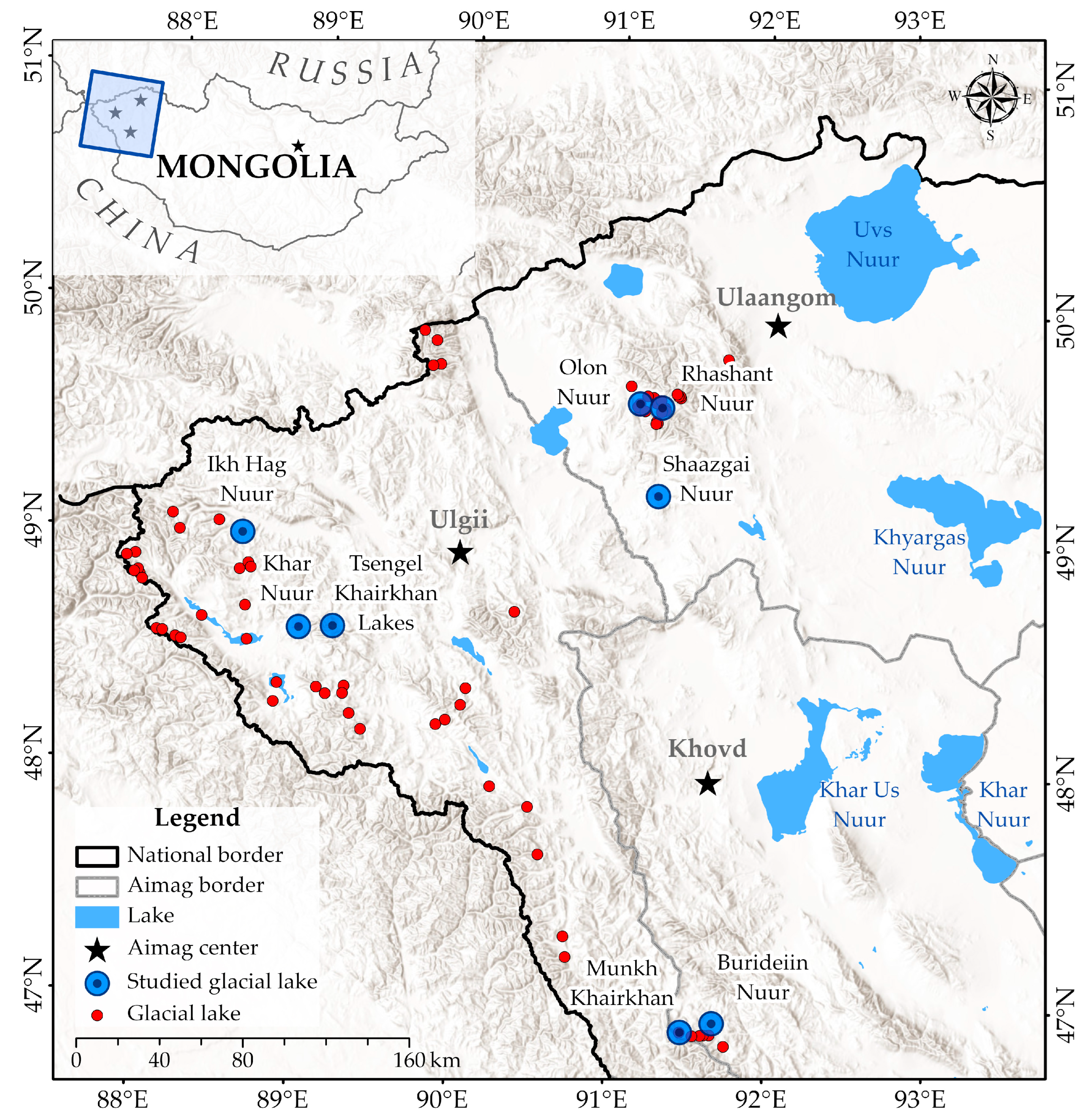
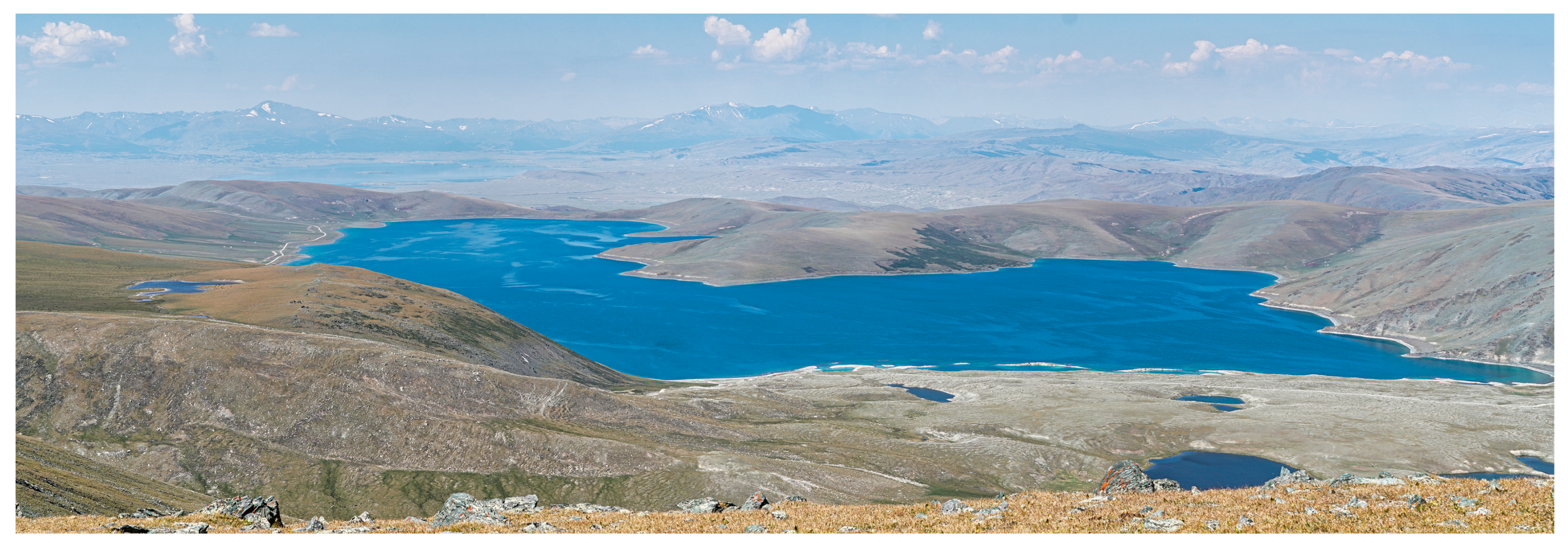
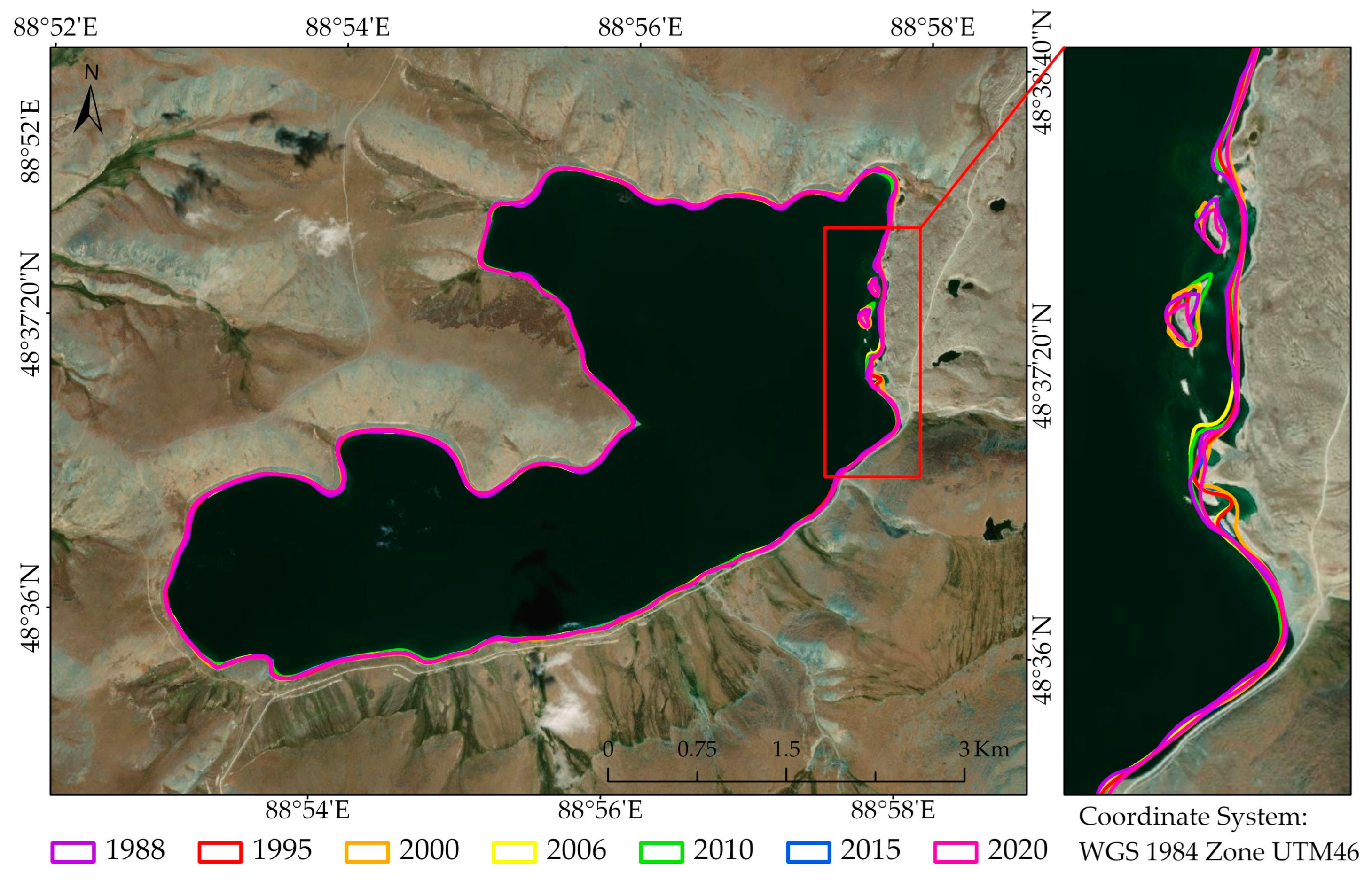
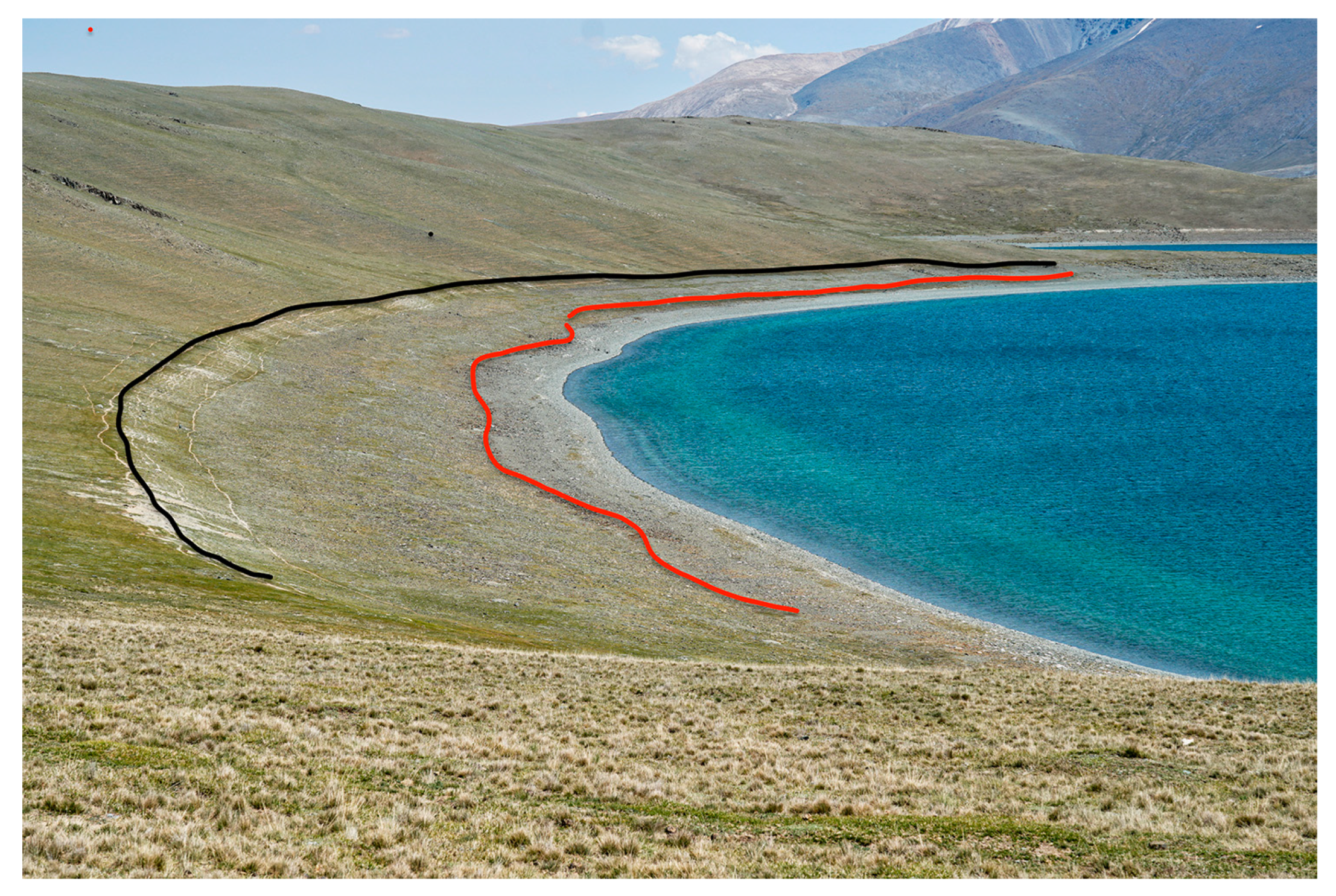
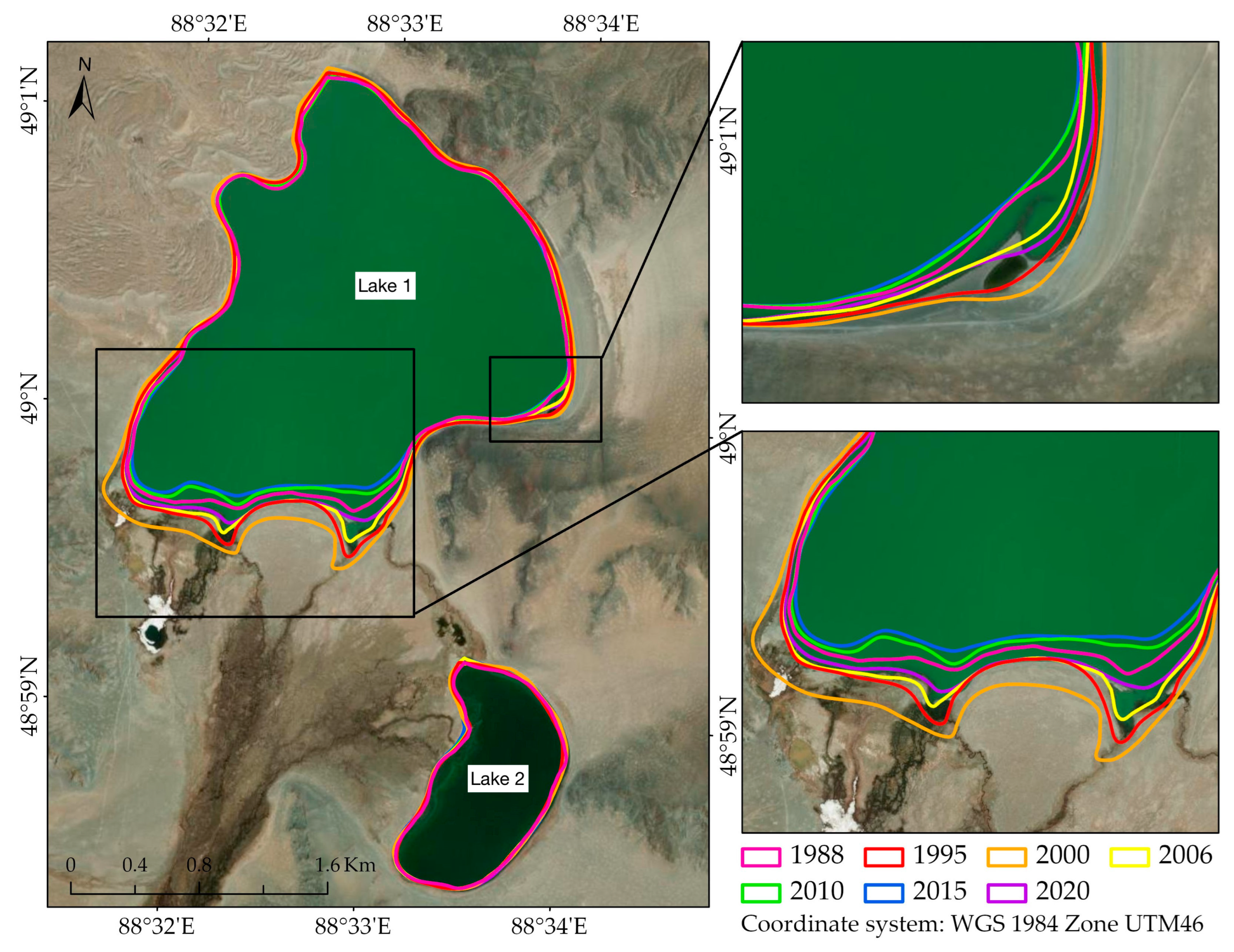
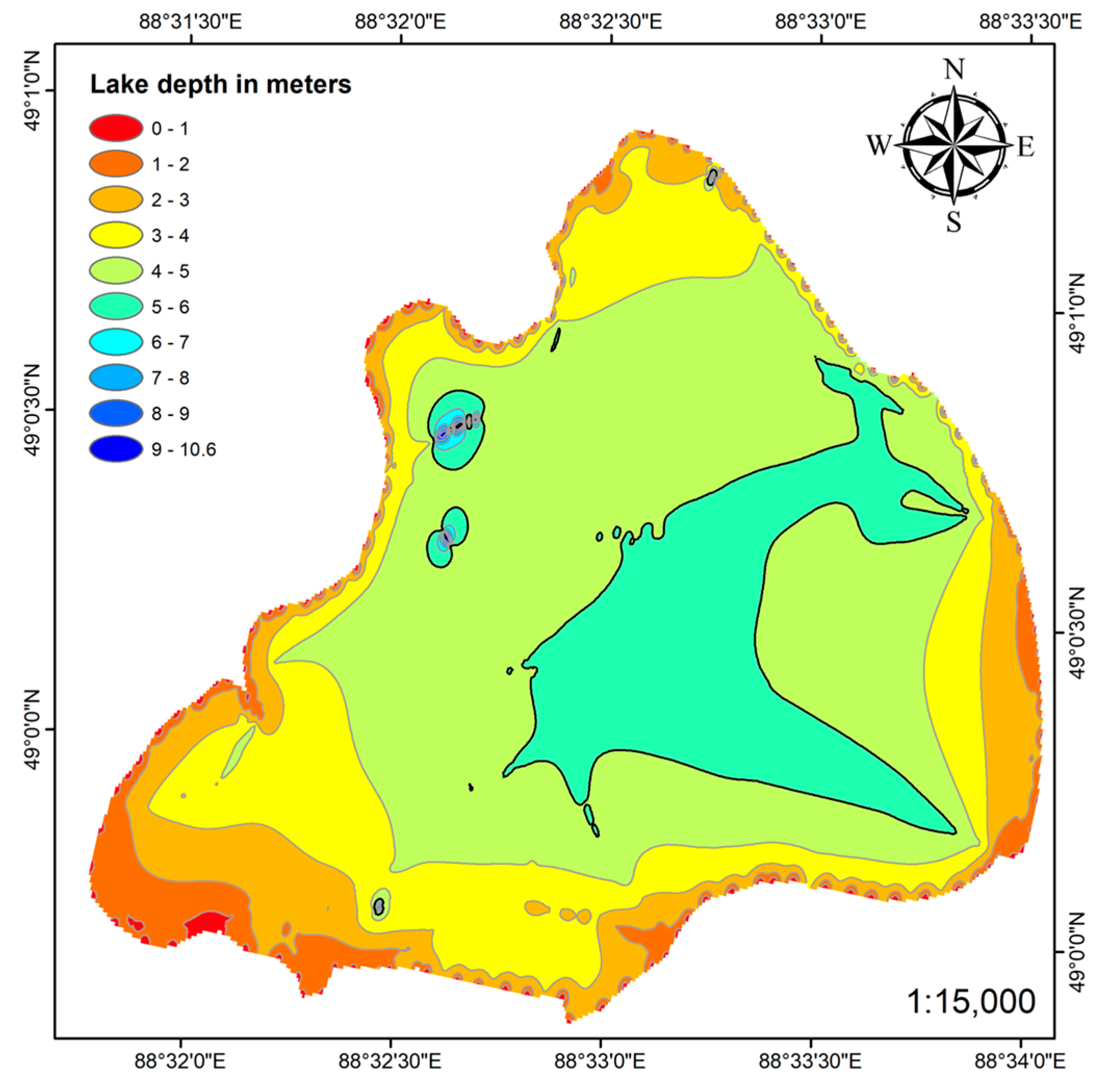
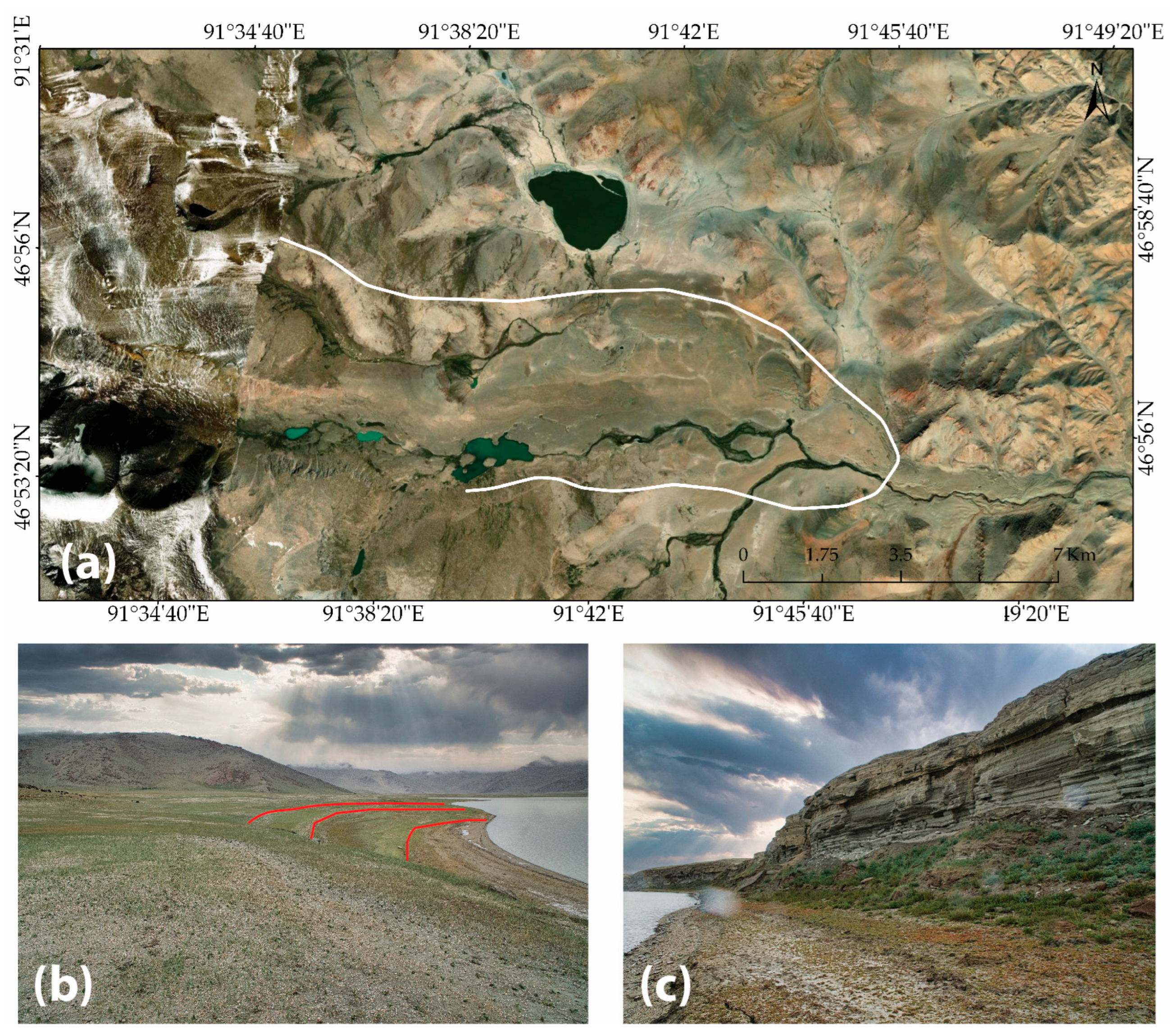
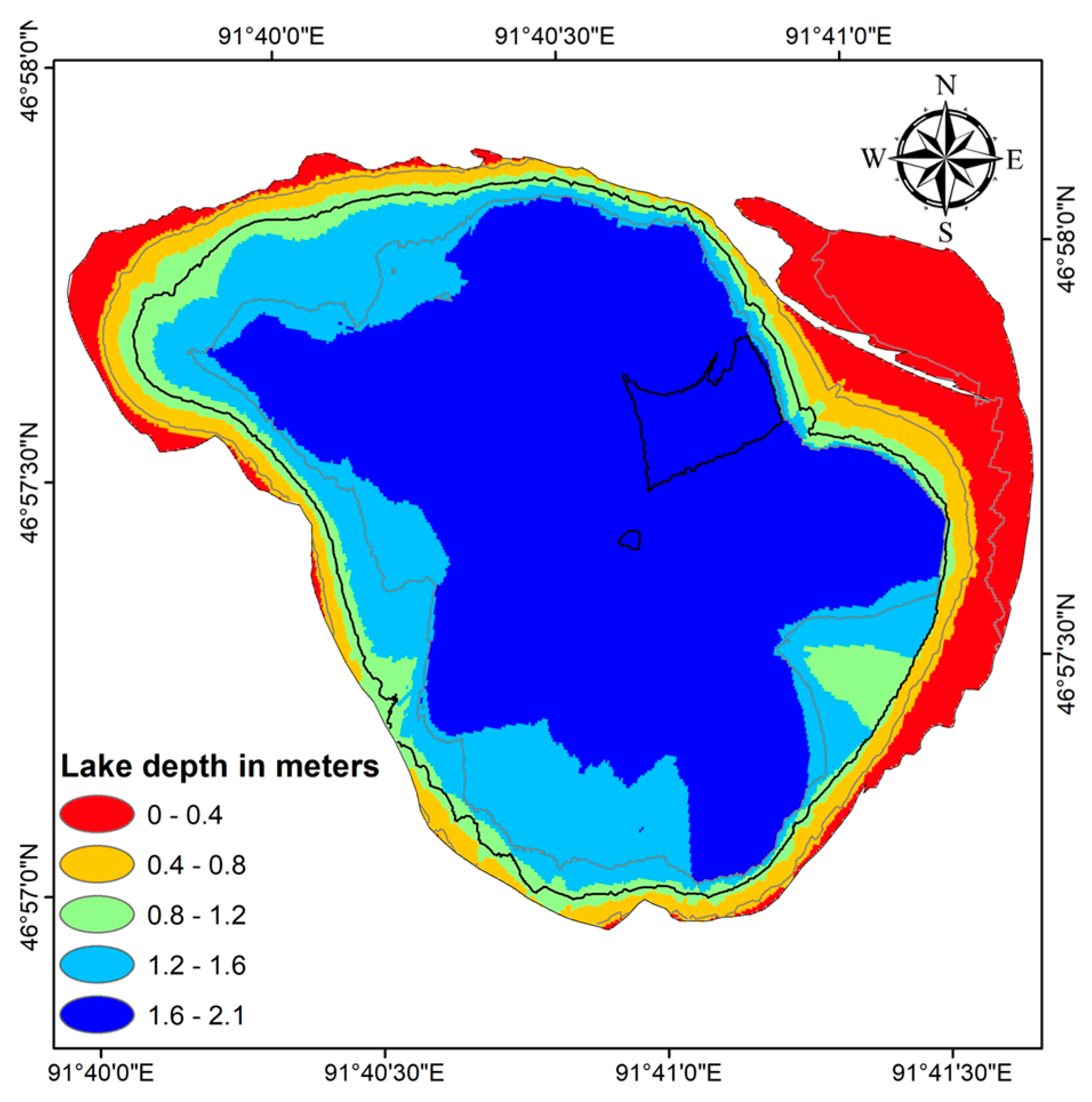
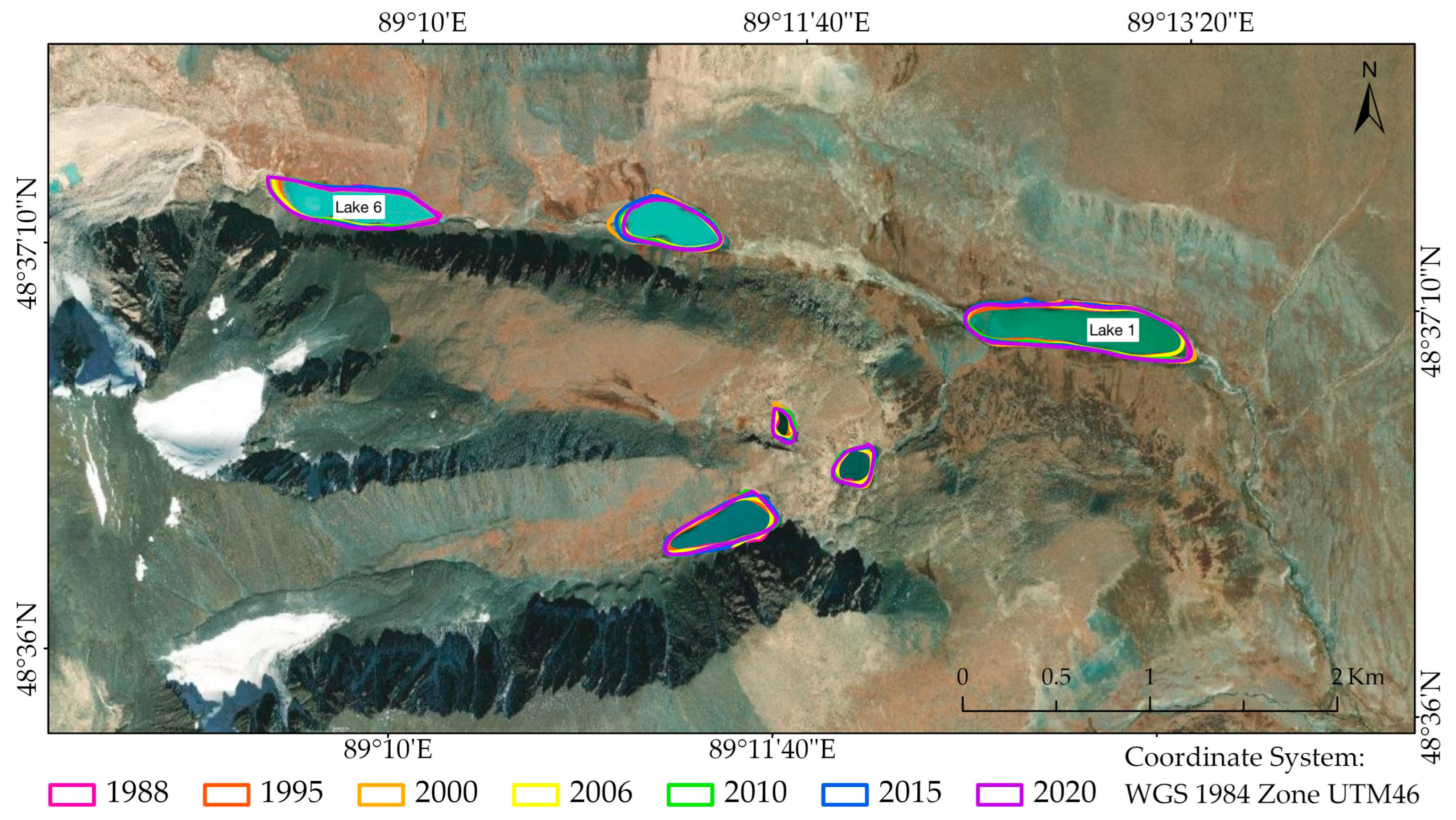
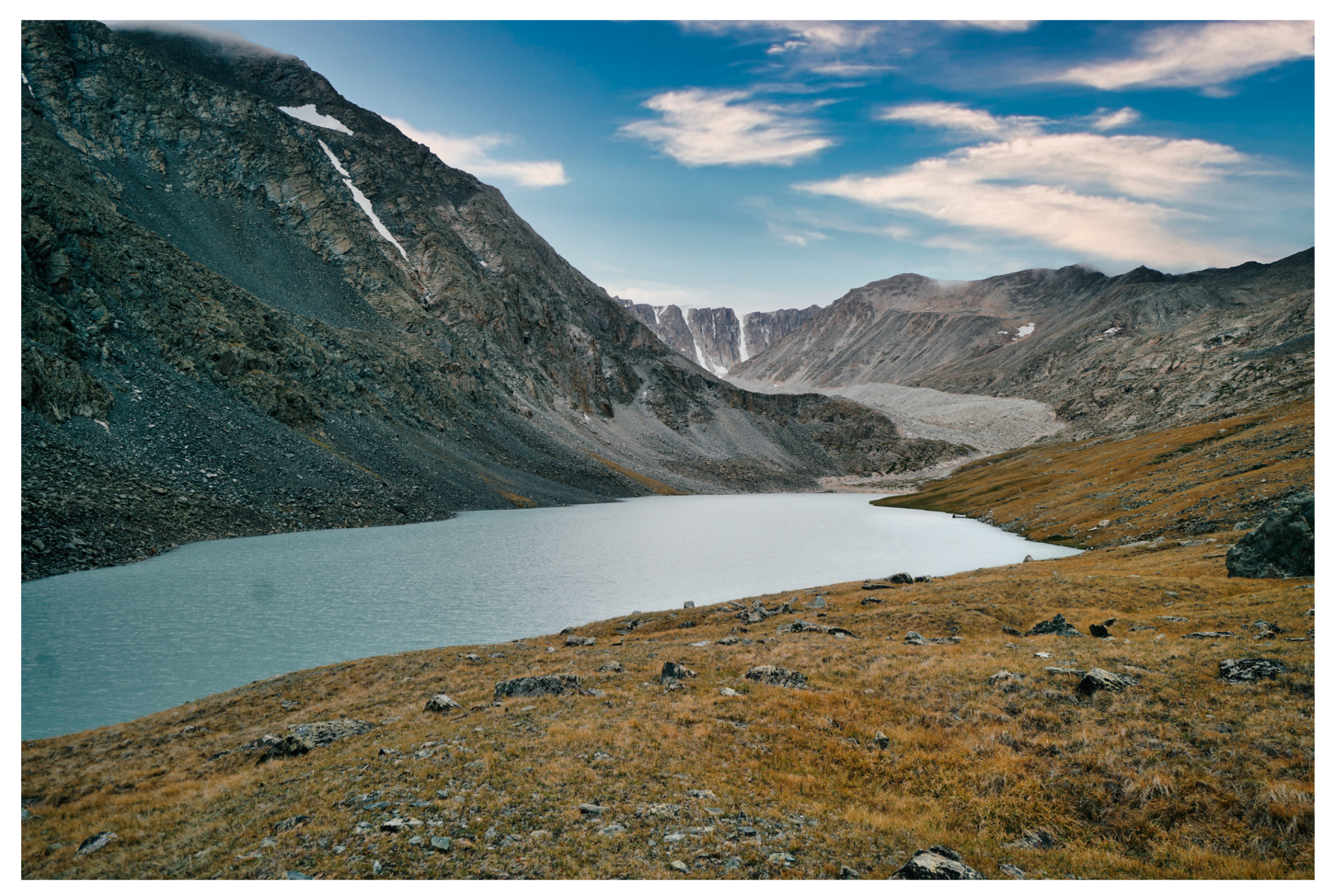
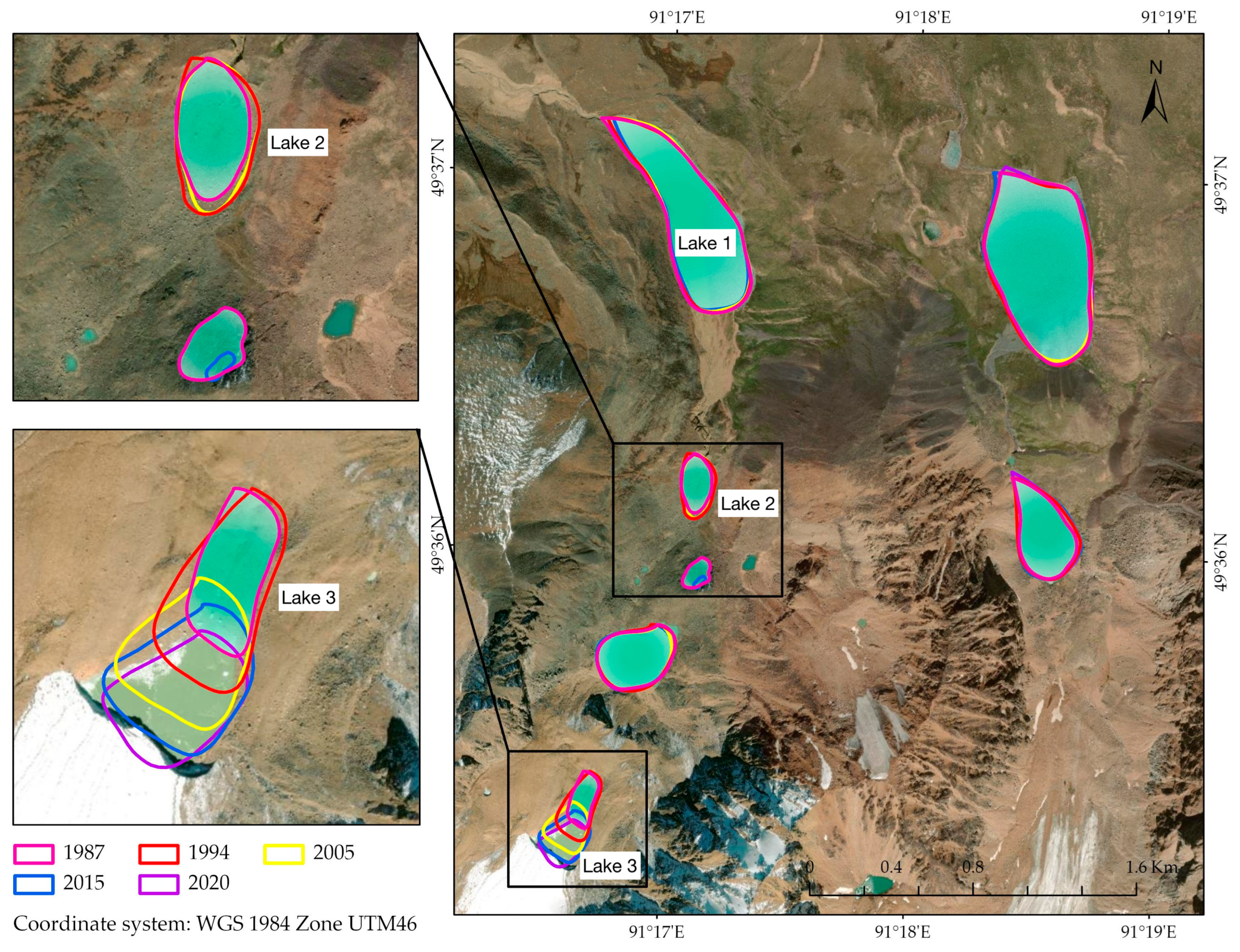
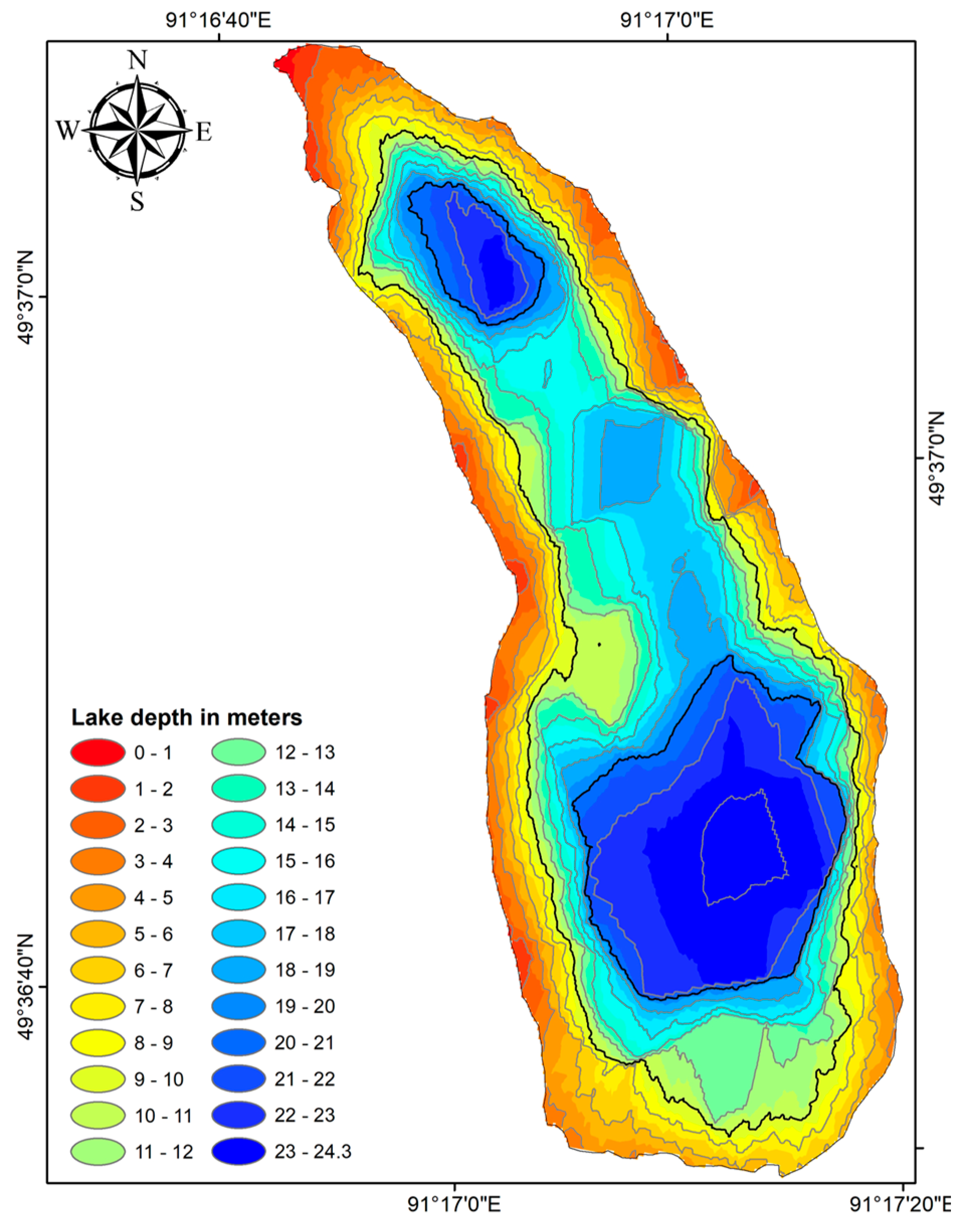
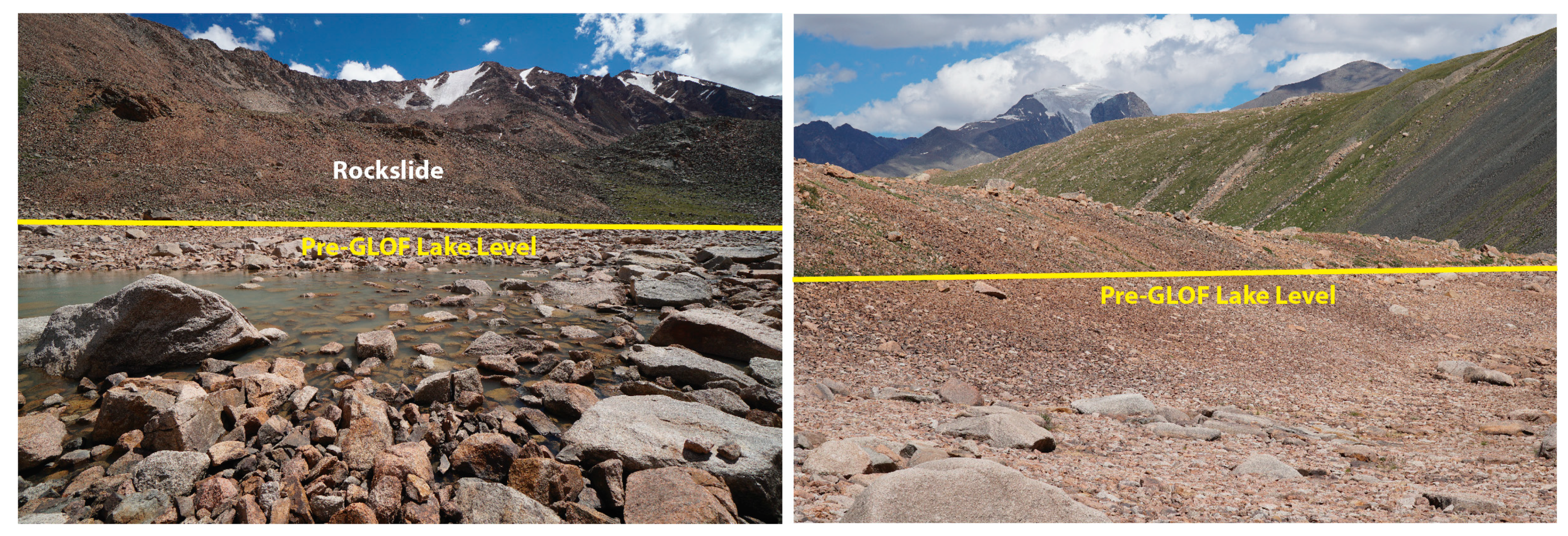
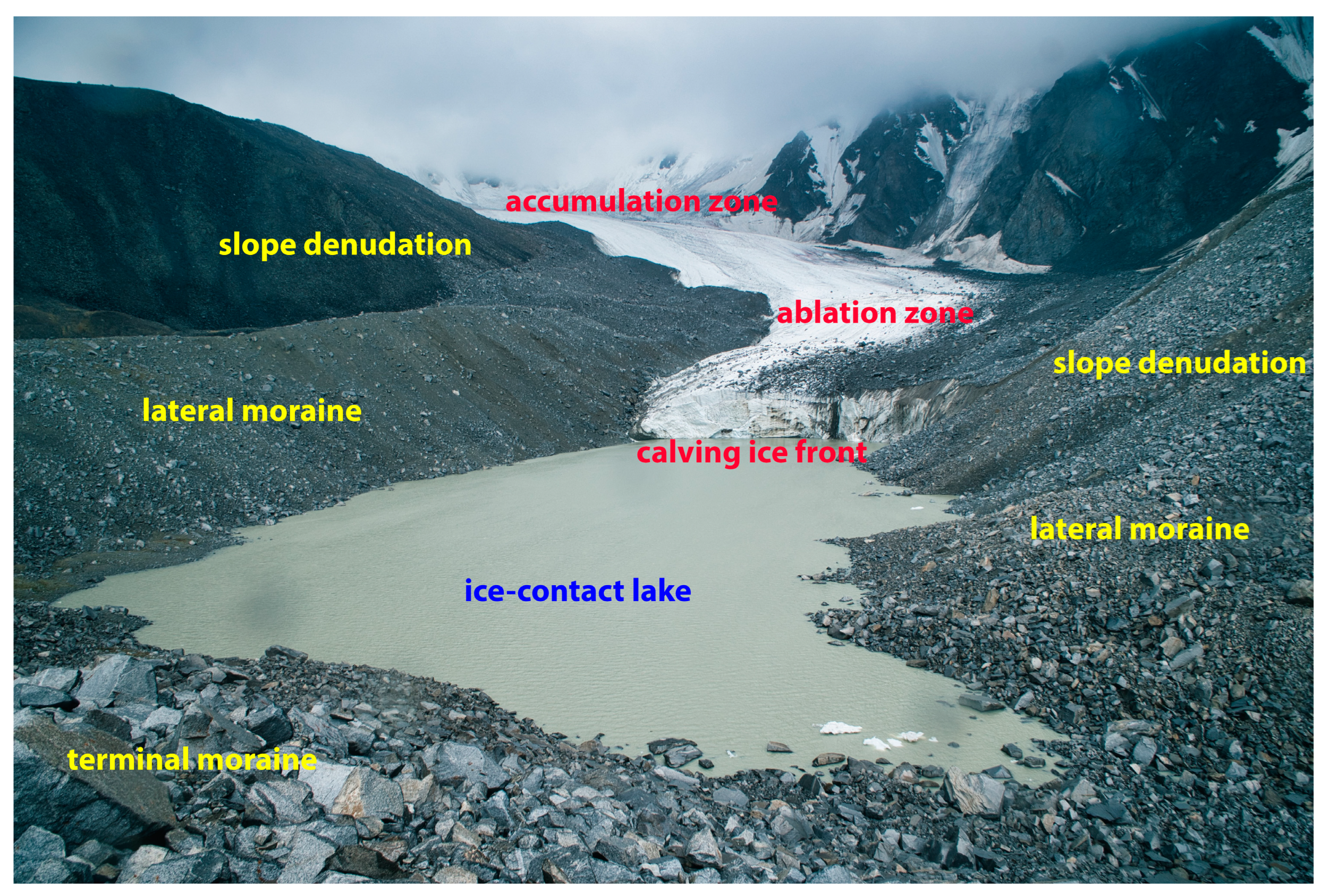
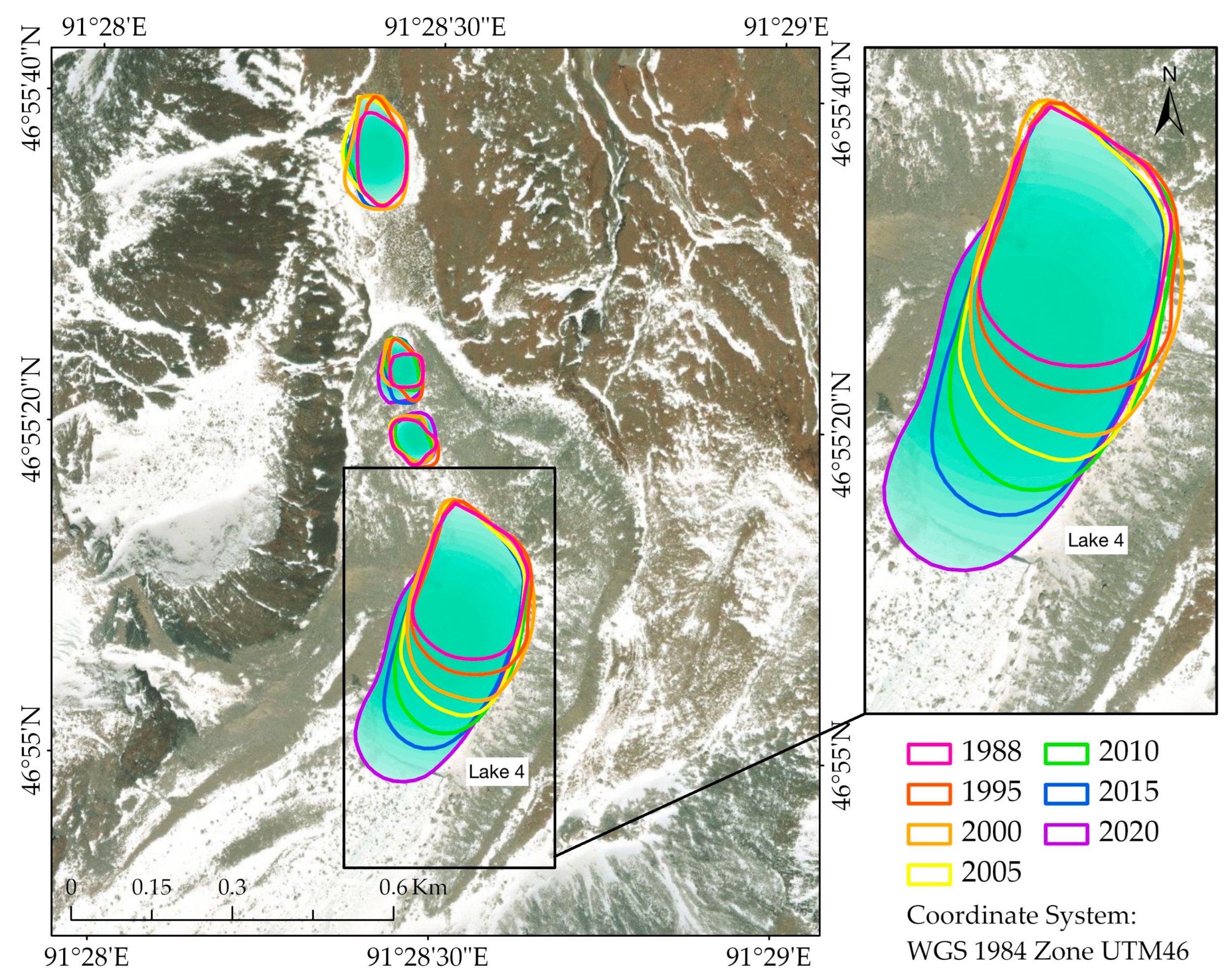
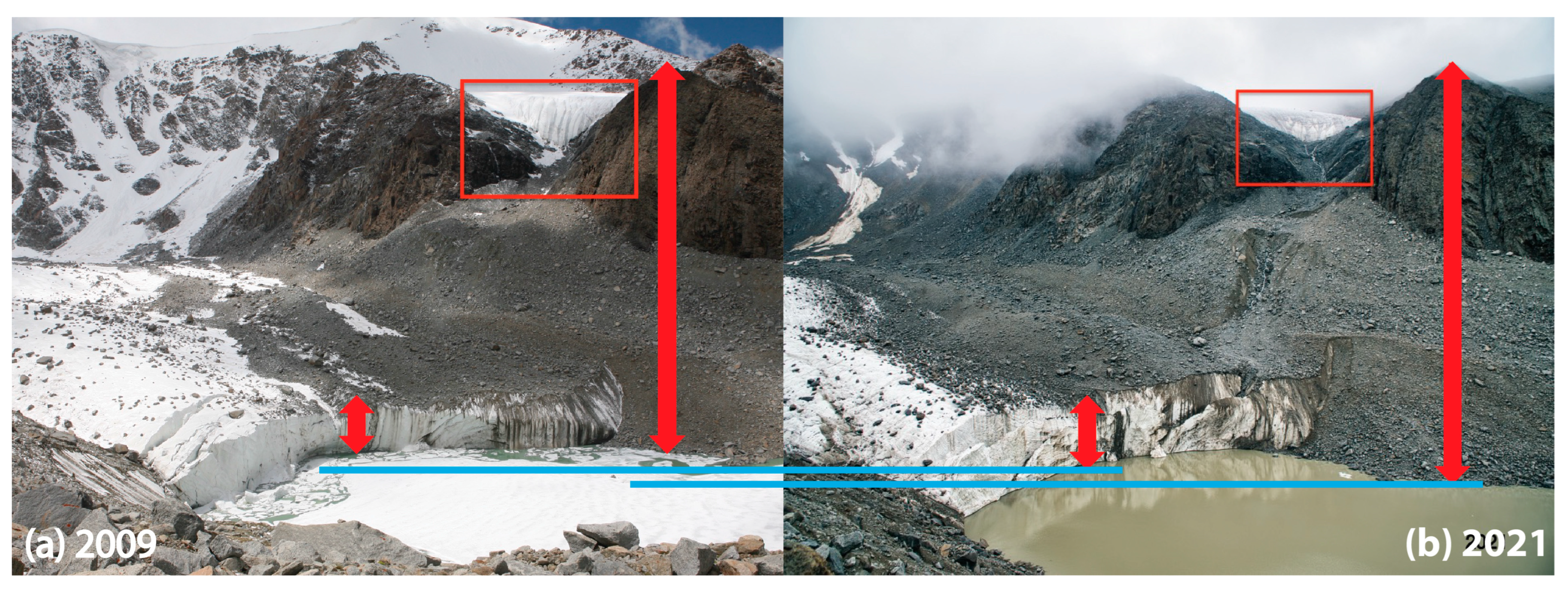
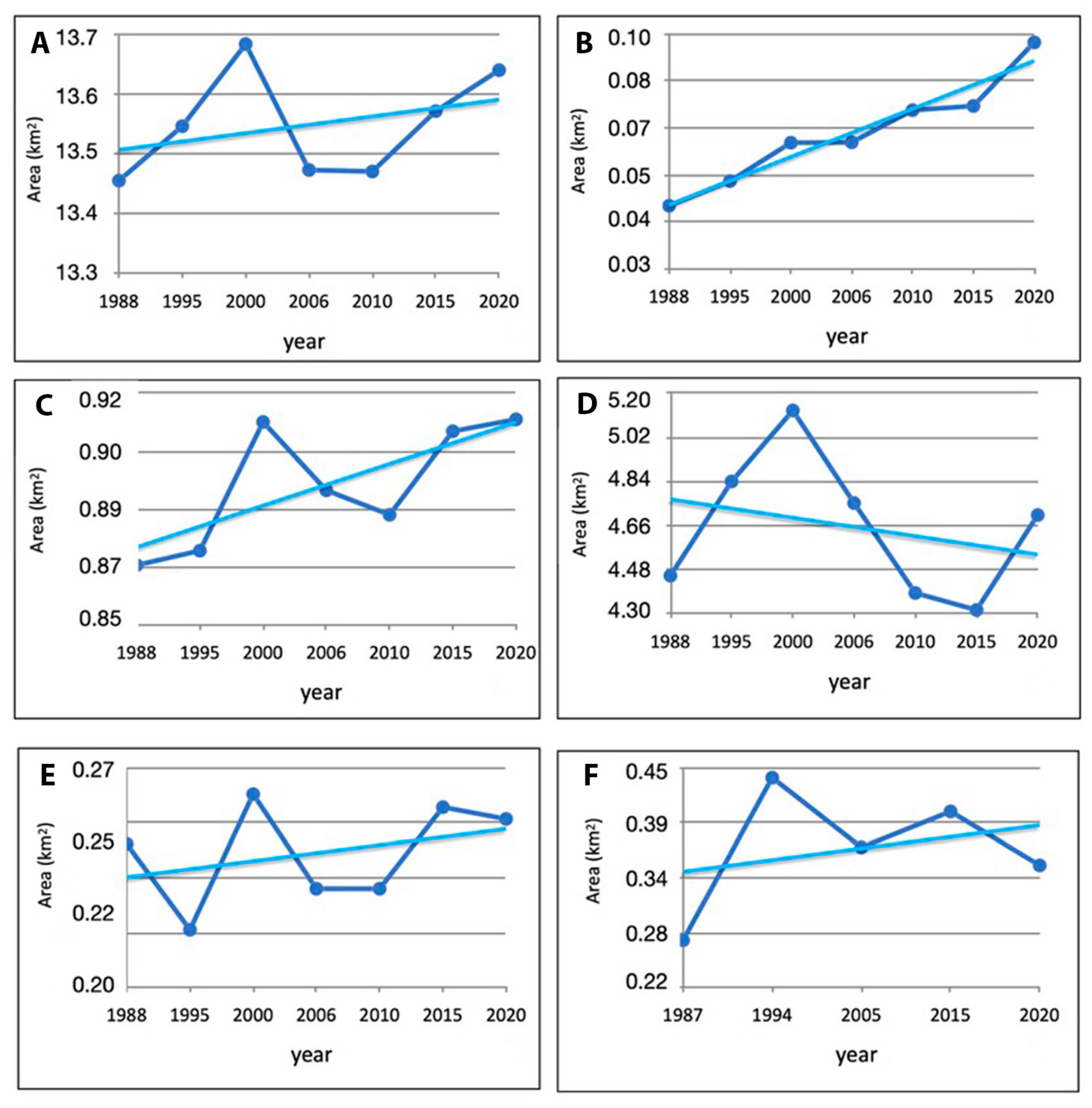
Disclaimer/Publisher’s Note: The statements, opinions and data contained in all publications are solely those of the individual author(s) and contributor(s) and not of MDPI and/or the editor(s). MDPI and/or the editor(s) disclaim responsibility for any injury to people or property resulting from any ideas, methods, instructions or products referred to in the content. |
© 2024 by the authors. Licensee MDPI, Basel, Switzerland. This article is an open access article distributed under the terms and conditions of the Creative Commons Attribution (CC BY) license (https://creativecommons.org/licenses/by/4.0/).
Share and Cite
Walther, M.; Kamp, U.; Nandintsetseg, N.-O.; Dashtseren, A.; Temujin, K. Glacial Lakes of Mongolia. Geographies 2024, 4, 21-39. https://doi.org/10.3390/geographies4010002
Walther M, Kamp U, Nandintsetseg N-O, Dashtseren A, Temujin K. Glacial Lakes of Mongolia. Geographies. 2024; 4(1):21-39. https://doi.org/10.3390/geographies4010002
Chicago/Turabian StyleWalther, Michael, Ulrich Kamp, Nyam-Osor Nandintsetseg, Avirmed Dashtseren, and Khurelbaatar Temujin. 2024. "Glacial Lakes of Mongolia" Geographies 4, no. 1: 21-39. https://doi.org/10.3390/geographies4010002
APA StyleWalther, M., Kamp, U., Nandintsetseg, N.-O., Dashtseren, A., & Temujin, K. (2024). Glacial Lakes of Mongolia. Geographies, 4(1), 21-39. https://doi.org/10.3390/geographies4010002






